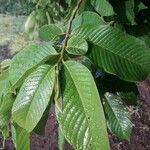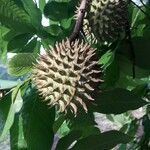Tree with ferruginous-tomentose branchlets. Leaves deciduous, on 3-5 mm. long petioles, membranaceous, on the upper side shortly and thinly, on the nerves more densely hirsute, finally more or less glabrate, underneath longer ferruginous-hirsute along the nerves, obovate or elliptic-obovate, rotundate at the base, shortly acuminate at the apex, 12-30 cm. long and 6-14 cm. broad. Flowers solitary, sub-sessile; flower bud enclosed at first by an involucre composed of 2 sessile acuminate bracts. Calyx lobes triangular-ovate, acuminate, 1-2 cm. long. Outer petals valvate, thick, rigid, ovate-lanceolate, gradually tapering into a long, obtuse apex, up to 5 cm. long and 2 cm. broad, ferruginous-sericeous on the outside, inner petals imbricate, thinner, elliptic-oblong, rotundate at the apex, 2.5 cm. long. Stamens 5-6 mm. long. Fruit globose, up to 20 cm. in diameter, bearing numerous pyramidal protuberances and clothed with brown felt-like tomentum. Seeds 28-30 cm. long.
More
A small tree. It can grow 6-7 m high. It has a short trunk 45 cm across. The branches are spreading and have a rusty woolly covering when young. It loses its leaves during the year. The leaves are wavy and narrowly oval. They are 20-30 cm long by 10-14 cm wide. The flowers have a strong scent. The flowers occur singly and are fleshy. They are large and cone shaped. The fruit are large and brown. They are 15-20 cm across. They have sweet aromatic pulp. The flesh is bright orange and soft. There are soft spines on the skin.




